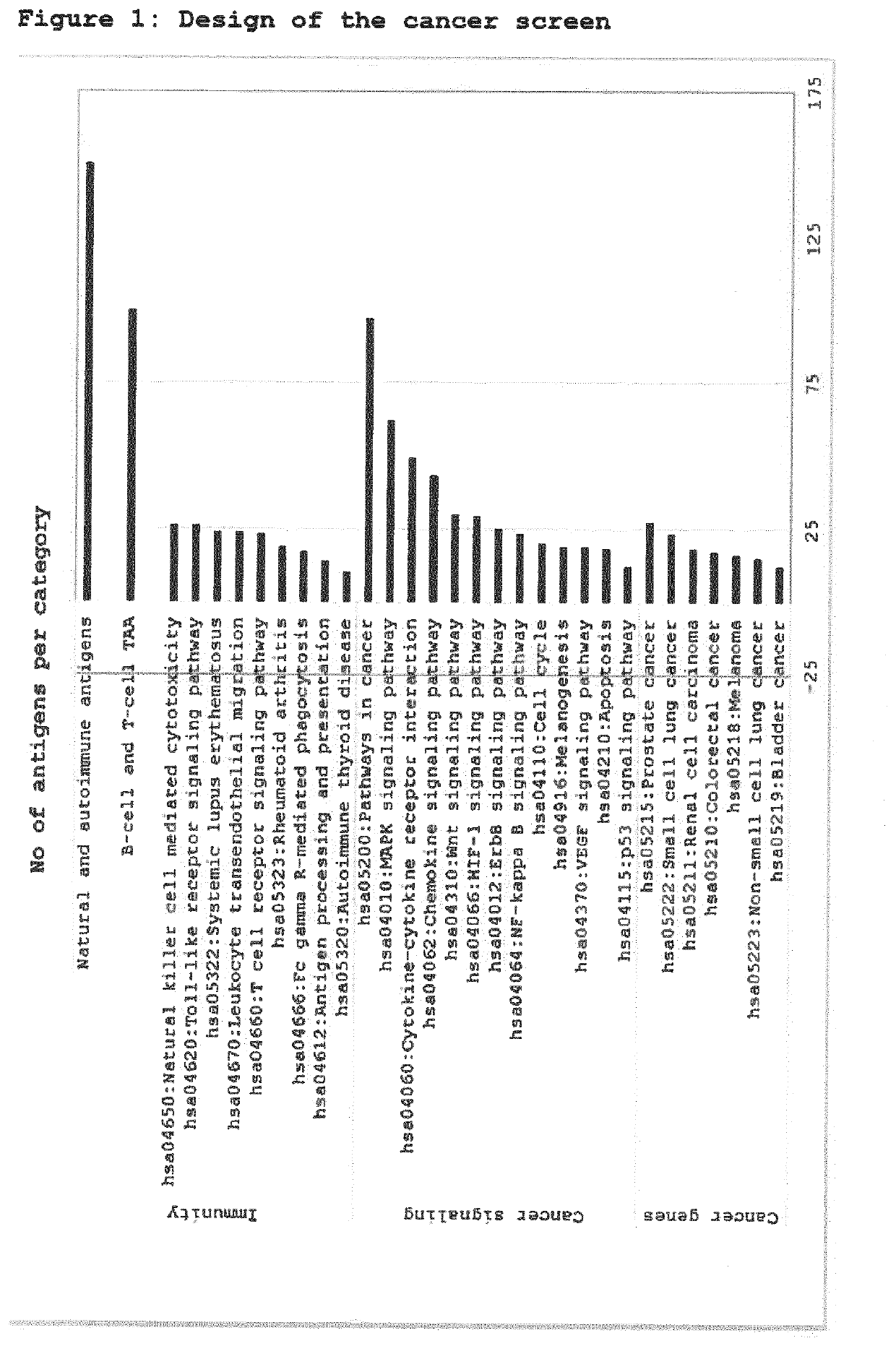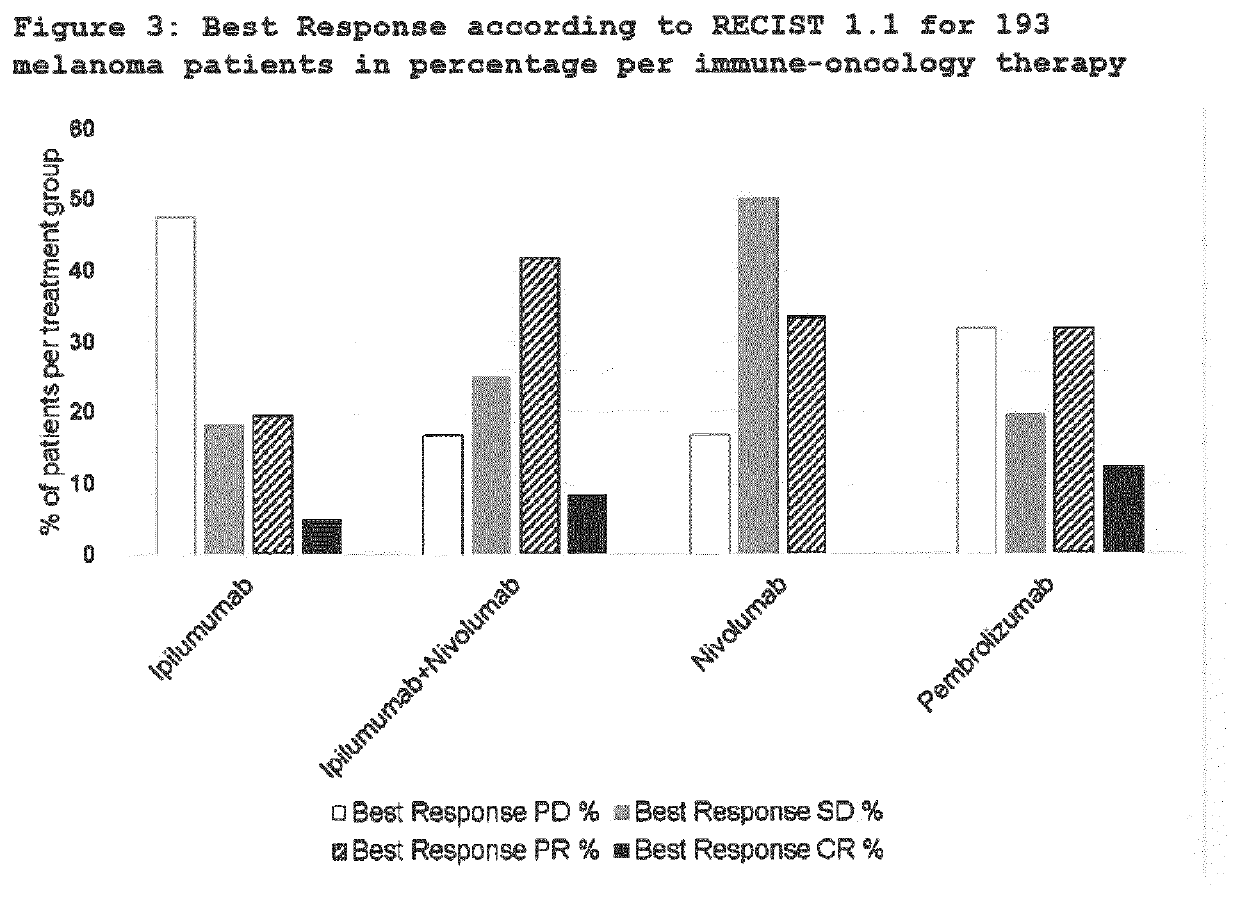Melanoma biomarkers
a technology of melanoma and autoantibody, applied in the field of melanoma biomarkers, can solve the problems of poor prognosis development of severe and even life-threatening colitis, and poor survival rate of patients with metastatic melanoma
- Summary
- Abstract
- Description
- Claims
- Application Information
AI Technical Summary
Benefits of technology
Problems solved by technology
Method used
Image
Examples
example 1
Production of Recombinant Autoantigens
[0322]Recombinant antigens were produced in Escherichia coli. Five cDNA libraries originating from different human tissues (fetal brain, colon, lung, liver, CD4-induced and non-induced T cells) were used for the recombinant production of human antigens. All of these cDNA libraries were oligo(dT)-primed, containing the coding region for an N-terminally located hexa-histidine-tag and were under transcriptional control of the lactose inducible promoter (from E. coli). Sequence integrity of the cDNA libraries was confirmed by 5′ DNA sequencing. Additionally, expression clones representing the full-length sequence derived from the human ORFeome collection were included. Individual antigens were designed in silico, synthesized chemically (Life Technologies, Carlsbad, USA) and cloned into the expression vector pQE30-NST fused to the coding region for the N-terminal-located His6-tag. Recombinant gene expression was performed in E. coli SCS1 cells carryi...
example 2
Selection of Antigens and Design of the Cancer Screen
[0324]A bead-based array was designed to screen for autoantibodies binding to tumor-associated antigens (TAA), proteins expressed from mutated or overexpressed cancer genes, and proteins playing a role in cancer signaling pathways. Furthermore, self-reactive antigens of normal humans and typical autoimmune antigens were included. In total, 842 potential antigens were selected. FIG. 1 shows the number of screening antigens per category.
example 3
Coupling of Antigens to Beads
[0325]For the production of bead-based arrays (BBA), the proteins were coupled to magnetic carboxylated color-coded beads (MagPlex™ microspheres, Luminex Corporation, Austin, Tex., USA). The manufacturer's protocol for coupling proteins to MagPlex™ microspheres was adapted to use liquid handling systems. A semi-automated coupling procedure of one BBA encompassed 384 single, separate coupling reactions, which were carried out in four 96-well plates. For each single coupling reaction, up to 12.5 μg antigen and 8.8×105 MagPlex™ beads of one color region (ID) were used. All liquid handling steps were carried out by either an eight-channel pipetting system (Starlet, Hamilton Robotics, Bonaduz, Switzerland) or a 96-channel pipetting system (Evo Freedom 150, Tecan, Männderdorf, Switzerland). For semi-automated coupling, antigens were dissolved in H2O, and aliquots of 60 μl were transferred from 2D barcode tubes to 96-well plates. MagPlex™ microspheres were homo...
PUM
| Property | Measurement | Unit |
|---|---|---|
| median survival time | aaaaa | aaaaa |
| pH | aaaaa | aaaaa |
| pH | aaaaa | aaaaa |
Abstract
Description
Claims
Application Information
 Login to View More
Login to View More - R&D
- Intellectual Property
- Life Sciences
- Materials
- Tech Scout
- Unparalleled Data Quality
- Higher Quality Content
- 60% Fewer Hallucinations
Browse by: Latest US Patents, China's latest patents, Technical Efficacy Thesaurus, Application Domain, Technology Topic, Popular Technical Reports.
© 2025 PatSnap. All rights reserved.Legal|Privacy policy|Modern Slavery Act Transparency Statement|Sitemap|About US| Contact US: help@patsnap.com



